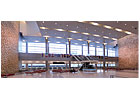
Photo by Brad J. Goldberg
The new South Terminal at Miami International Airport in Miami, FL, features two expansive sculptural walls made of Etrusca travertine, which were hand carved by Brad J. Goldberg of Dallas, TX
The new South Terminal at Miami International Airport in Miami, FL, features two expansive sculptural walls made of Etrusca travertine, which were hand carved by Brad J. Goldberg of Dallas, TX
Those traveling through the new South Terminal at Miami International Airport in Miami, FL, will be greeted by more than security gates and baggage claim carousels. Within the new structure is literally a work of art, which was created by sculptor Brad J. Goldberg of Dallas, TX. Titled “Coral Eden,” the project features two expansive Italian travertine walls - each stretching approximately 100 feet tall and 30 feet wide and intricately carved to resemble Brain Coral.
“This project started somewhere around 1996,” said Goldberg. “It was about a 10-year process. Miami-Dade County was planning a new international terminal at the Miami International Airport. It’s a huge terminal for international flights and U.S. Customs, and it took about five to six years just for construction.”
The sculptor went on to explain that two local architectural firms - Rodriguez & Quiroga Architects and Borrelli & Associates - were responsible for the terminal’s design. “I was commissioned by an entity called Miami-Dade Art in Public Places,” he said. “The area in which I decided to work starts on the baggage claim level and transitions up 100 feet in height and is 30 feet wide, passing through the ticketing level, a third floor ‘Meeter Greeter’ lobby and up through this expansive space to the ceiling where there is a skylight that brings natural light into the space. As such, it is appreciated on many public levels of the building.”
Miami-Dade Art in Public Places serves the community through the implementation of art installations and educational programming dedicated to enriching the public environment, and to preserving and enhancing the artistic and civic pride of Miami-Dade County, reports the organization. It promotes collaboration and creative art projects that improve the visual quality of public spaces.
The inspiration for “Coral Eden” came to Goldberg while he was visiting Villa Vizcaya - a National Historic Landmark and museum in Miami-Dade County. “All the gardens are built of coral,” said the sculptor, explaining that coral used to be a primary building stone in the Miami area until it got overused and the quarries got overtaxed. “It is an incredibly beautiful material, and as I was looking at it, I had a momentary glimpse of an idea - overscaled ‘Coral’ bookend walls that became a feature point of the public spaces in the new terminal. It was a five-minute idea to take coral and expand it to a super scale where travelers felt small in comparison to the image of being within a Coral Reef.”
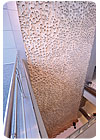
The inspiration for “Coral Eden” came to Goldberg while he was visiting Villa Vizcaya - a National Historic Landmark and museum in Miami-Dade County. The sculptor designed the walls to resemble Brain Coral, which is endangered and organic in nature.
Realizing an idea
To begin his project, Goldberg began taking macro photos of Brain Coral in Miami. “Out of hundreds of photographs, I selected two and blew them up to the scale of the architectural walls themselves,” he said. “Diana Goldberg, my wife and partner, then spent weeks religiously tracing, exactly, the photographs themselves in AutoCAD. Two types of Brain Coral were developed as such.”The sculptor explained that Brain Coral is currently an endangered species worldwide. “I wanted, through the vehicle of art, to call attention to the fact that coral is in trouble and that it is an incredible example of a natural organic architecture,” said Goldberg. “The architecture of the airport, as many new airports today, is modernist in character with stainless steel and glass reflecting the technology of 21st century design and aeronautics. I used the coral to warm up [the design], create a counterpoint to the architecture and capture the spirit of Miami.”
While Goldberg had an idea for his project, he still needed to figure out the logistics of how to realize it. “It became an issue of, ‘How would one make something like this?’,” he said. “I toyed with the idea that since I’m a sculptor with 30 years of experience carving stone, why not carve it in my own studio? That, however, quickly became impractical in the limited timeframe, as the stone walls had to be installed relatively early in the construction process.”
With the vision of the stone walls looking like coral, the sculptor then had to find a material that would work. “I started searching for material,” he said. “I seriously looked for two years. Then 9/11 came, and the [airport] project was on hold. Finally, Miami-Dade County decided it was good for the local economy, so they resurrected it in 2002.”
In the end, Goldberg selected Etrusca travertine from the Bagni di Tivoli area of Italy for his creation. “I saw a piece of travertine that was cut against the grain - 99.9% of what you see is cut with the rift,” he explained. “I saw that the material revealed a texture that looked just like coral. It showed all the fossils. When I saw the material, I knew that was it, as it had just the same feeling as coral.”
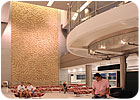
Each travertine wall stretches approximately 100 feet tall and 30 feet wide.
Fabricating the walls
Campolonghi Italia S.p.A. of Montignoso, Italy, was responsible for cutting all of the 176 stone panels that comprise both walls. “Dee Brown, Inc. [of Garland, TX] has installed most of my work for years now,” said Goldberg. “I am very close with them. They have many contacts with Italian fabricators, so we went to Campolonghi. They took me over to Italy. Campolonghi looked at the project, and I could see their brains working.“They were absolutely wonderful to work with,” continued the sculptor. “It was such a blessing. The project kept two of their 5-axis Omag CNC machines going non-stop for a full year.”
According to Goldberg, the large sculptural walls were formed with panels - each measuring 4 feet tall x 7.6 feet wide x 6 inches thick. “It ended up being comprised of 88 pieces per wall, and on either wall, no two pieces were alike,” he said. “Diana took the computer drawing of the wall and divided it into panel sizes. Then we worked with Campolonghi to make sure that all of the radii were consistent with the capabilities of their machines. They then took our AutoCAD drawings and translated them for the CNC machines.”
Each piece on the CNC machine took over 30 hours of continuous operation to cut, said Goldberg. “I designed the work so that down on the lower level of the wall, the relief of the travertine panel starts out as ½-inch deep, and as the wall rises in height, the depth of the bas-relief increases to about 3 inches, creating a sense of gradation,” he explained.
Before the panels were placed on the CNC machine for fabrication, a process called “blending” took place at the factory. “One of the things that I love about working in Italy is that standard,” said Goldberg. “We took all the slabs and laid them out on the floor. We then mixed and matched all these pieces for texture and color.”
Once the placement of the panels was determined, each piece was assigned a number, which was noted on the back and sides. This ensured that each panel would be installed in the correct place on the jobsite.
“After the blending was done, they started to fabricate,” said the sculptor. “I really wanted it to look very organic. Coral has texture. There are ventricles in it, so I hand-carved all the pieces [when they came off the CNC machine] to create a facsimile of that texture. Each piece took about three to four days to carve by hand.”
Goldberg went on to explain that after the hand carving was completed, the pieces went through a water-blasting process, which greatly enhanced the coral-like structure of the travertine. Additionally, the sculptor also created a bench that sits at the bottom of the walls. “The idea of the bench started as a way of protecting the wall from luggage carts and rolling suitcases,” he said. “I made it in such a way that it has a sculptural feeling to it. It’s made of Travertino Noce, a thin dark brown band that occurs in the Tivoli quarries that, when used as a bench, became a kind of ‘family member’ to the Etrusca travertine.”
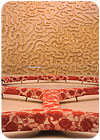
Photo by Brad J. Goldberg
The large sculptural walls were formed with panels - each measuring 4 feet tall x 7.6 feet wide x 6 inches thick. “It ended up being comprised of 88 pieces per wall, and on either wall, no two pieces were alike,” explained Goldberg.
The large sculptural walls were formed with panels - each measuring 4 feet tall x 7.6 feet wide x 6 inches thick. “It ended up being comprised of 88 pieces per wall, and on either wall, no two pieces were alike,” explained Goldberg.
Managing the details
Giovanni D’Angiolo, who has been an independent consultant in the stone business for 34 years, was hired as Senior Project Manager. He worked with Campolonghi, Goldberg and Dee Brown to make sure that the project ran smoothly on all ends.“Every project can be unique - like someone’s office table or a private bathroom - and it requires special steps to ensure that the expectations of the client are fulfilled,” said D’Angiolo. “Coral Eden was a very unique case. It was a piece of art ‘for the many’ coming from a ‘single mind.’ The preparation process was crucial.”
Once Goldberg had chosen the stone type and finish, the preparation work began, according to D’Angiolo. This involved the research and studying of the most appropriate workmanship and finish; establishing a detailed manufacturing diagram unique for the project; establishing a detailed QA/QC plan unique for the project; selection of the specific strata at the quarry; selection of the best slab faces; dry laying and blending of the slabs prior to fabrication; programming and scheduling of the CNC machine; training personnel to assist the sculptor with the finishing work; dry laying of the finished panels; and packaging and finishing.
D’Angiolo traveled with Goldberg to the quarry in Bagni di Tivoli, near Rome, for the material selection process. “A very specific strata from a specific quarry was chosen that gave the artist the right color shade, structural strength, porosity, workability for both the CNC machine and hand tools, and the right reaction to the waterjet final finish,” he said.
The Senior Project Manager also explained that Campolonghi has experience in handling special projects such as this. “They are flexible to adapt to the various circumstances involving special sizes and [other] requirements,” said D’Angiolo. “Nevertheless, a number of out-of-the-ordinary measures were taken, such as making extraordinary large areas available to dry lay walls and customizing some equipment to obtain special finishes on 6-inch-thick panels.”
Once the travertine panels were ready for shipment to the U.S., care was taken to package them properly. “The finished surfaces were obviously very precious,” said D’Angiolo. “In order to protect them, we limited the number of pieces per crate to two, and we positioned the finished faces in the most protected position. Crates were fully closed, and pieces inside were wrapped with heavy-duty plastic sheets. The loading in the container was not optimized for weight, but rather for safe loading of the crates.”
Overall, communication was key to a successful operation, explained D’Angiolo. “Very large heavy panels had to be worked to high accuracy, down to 1/10 millimeter,” he said. “The fabrication involved both the precision and accuracy of the CNC machine and the touch and human judgment for the hand sculpting. Key to the idea was the ability for the panels to be hoisted into place without needing any additional carving on site to make a perfect match. To achieve this, the completed panels were once again dry-laid on the ground at Campolonghi to ensure a perfect match. As such, there was a perfect fit during installation that required no on-site mating. The interaction between the artist and the fabricator is crucial. Mr. Goldberg is especially gifted in explaining and working with all people involved at all levels.”
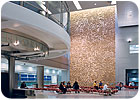
Photo by Brad J. Goldberg
Although not fully up and running, the new South Terminal opened to the public in November of 2007.
Although not fully up and running, the new South Terminal opened to the public in November of 2007.
Installing the panels
And while the entire fabrication process - from “blending” the stone panels to hand-chiseling the travertine to get just the right texture - was very involved, a great amount of thought and planning also was necessary for the installation. “The installation went extremely smooth,” said Rob Barnes, president of Dee Brown, Inc. in Dallas, TX. “There was an extreme amount of pre-planning that we all did. So when materials hit the site, we could get in and get out. We sent a very skilled crew down there.”Each wall was shipped in its entirety from Campolonghi’s factory in Italy to the jobsite in Miami. There was a three-month interval in between the installation of each wall, according to Barnes.
“We had Campolonghi hold the entire wall and ship it at one time,” he said. “The job was in Miami, and we are based in Dallas. Because of the value of the stone, we didn’t want it sitting around and subject to damage. We timed the delivery of stone so that it was shipped at one time for each wall, and it was delivered as we arrived at the jobsite.”
For one of the walls, the installation involved building a structural steel frame to attach the stone to because it was being placed on a concrete shear wall, explained Barnes. “Each stone panel was individually supported,” he said. “An anchor design was such that I could pull one of the stone [pieces] out of the wall, and the others would stay up there. They were on stainless steel clips. Those clips attached back to the steel structure and went into a kerf. There is a slot in the top and bottom of the stone.
“We did do something really unusual with the installation on that wall,” Barnes went on to say. “We took a Hydro Mobile scaffold system, which is typically a platform-type scaffold that usually runs with a gas engine, and we had it converted to an electric engine because we were inside. Also, it was designed so that we could hoist stone off of the wall face in the front rather than the rear.”
Re-engineering the hoist system was probably the largest factor that assisted with installing the travertine panels at a quick pace. “Basically, these stones weighed somewhere in the neighborhood of 2,200 pounds each,” said Barnes. “Nobody was picking them up. We tried to minimize handling wherever possible because of the size and weight [of the panels].”
With a five-man crew, it took approximately five to six weeks to install the first wall. “The reason it took longer the first time was because of the installation of the steel framing,” explained Barnes. “The second wall went much faster because we didn’t have to build the framing.”
The second wall, which required a four-man crew and took about three weeks to complete, was installed on a concrete block substrate. And as with the first wall, the engineering was done so that each stone panel was individually self-supported with an anchor system.
For both walls, the installers had to pay attention to the number on the back and side of each stone panel. “Every panel had a specific place it had to go because of the patterning of the stone,” said Barnes. “Every piece was different.”
Overall, the installation ran smoothly, according to the installer. “It was unique for us as an installer not working for a general contractor,” he said, explaining that they worked directly for the artist. “Integral to the entire process were our inspectors, Raoul Luciani and Pietro Bandelloni of Pietrasanta, Italy. They helped Mr. D’Angiolo with the color selection and blending of the completed stones that would ultimately receive Mr. Goldberg’s final approval in Italy before each wall was shipped. Every stone piece was checked and verified for its accuracy. There was a lot of work done on the front end of the job that you never see.”
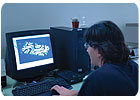
“Diana, [my wife and partner], took the computer drawing of the wall and divided it into panel sizes,” said Goldberg. “Then we worked with Campolonghi to make sure that all of the radii were consistent with the capabilities of their machines. They then took our AutoCAD drawings and translated them for the CNC machines.”
Completing the job
The new terminal at Miami International Airport featuring “Coral Eden” opened to the public in November of 2007. “The operation of the terminal is still somewhat limited right now,” explained Goldberg. “It is not at full capacity yet, but it is open and flights are coming in and out.”When talking about the unique project, the sculptor explained that working at Campolonghi’s factory in Italy was one of the more interesting aspects of the job. “In my opinion, the most interesting part is how it seemed to affect the stone culture in the Pietrasanta, Querceta, Montignoso, Massa and Carrara area,” he said. “When I said that I wanted to hand carve all these pieces after they were on the [CNC machines], they thought I was nuts. They said, ‘Nobody does this anymore.’ But in the end, we did.”
Goldberg went on to explain that he had a great working relationship with Campolonghi. “During the time [that we were working on the project], people flocked to Campolonghi to see it because they heard about it and because of the scale,” he said, adding that the view of the mock-up panels at Campolonghi caused a lot of people to stop on the Via Aurelia and take a look. “The people there were very ingenious about figuring out how to do it. They hadn’t done something like this before. My work is essentially that; making things that people haven’t seen before.”
